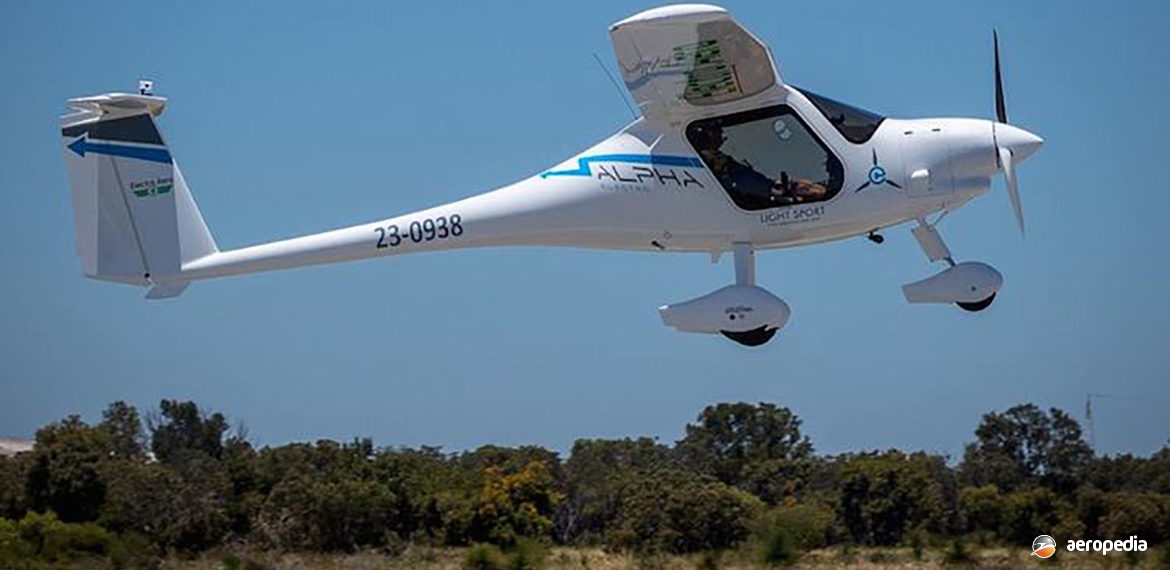Photograph:
Pipistrel Alpha Electro 23-0938 (c/n 570AE60LSA) at Jandakot, WA in January 2018 (Electro Aero)
Country of origin:
Slovenia
Description:
Two-seat light training and sport aircraft
Power Plant:
One 60 kw (80 hp) at 2000 rpm Siemens liquid-cooled electric motor driving a fixed-pitch 1.8 m (71 in) wooden propeller
Specifications:
- Wingspan: 10.5 m (34 ft 6 in)
- Length: 6.5 m (21 ft 6 in)
- Height: 2.75 m (6 ft 9 in)
- Wing area: 9.29 m² (100 sq ft)
- Never exceed speed: 250 km/h (155 mph)
- Max speed: 194 km/h (121 mph)
- Cruising speed at 75% power: 200 km/h (124 mph)
- Max speed with flaps down: 130 km/h (81 mph)
- Manoeuvring speed: 159 km/h (99 mph)
- Best climb speed: 139 km/h (86 mph)
- Max rate of climb: 372 m/min (1,220 ft/min)
- Stalling speed no flaps: 80 km/h (49 mph)
- Stalling speed with flaps: 69 km/h (43 mph)
- Take-off ground run: 140 m (459 ft)
- Take-off over 15 m (50 ft) obstacle: 295 m (968 ft)
- Service ceiling: 4,877 m (16,000ft)
- Endurance one hour plus: 30 mins reserve
- Cruise range: 150 km (93 miles)
- Max load factor: +4 and -2 G
- Empty weight without batteries: 251 kg (553 lb)
- Empty weight with batteries: 377 kg (831 lb)
- Max weight for two pilots: 200 kg (440 lb)
- Loaded weight: 550 kg (1,212 lb)
- Weight of standard battery system: 126 kg (277 lb)
History:
The Alpha Electro is one of the first of a new generation of light training aircraft powered by electric motors and has been developed by Pipistrel, which is based in Slovenia’s Vipava Valley. The prototype of this model was initially known as the WATTsUP and was developed in partnership with German company Siemens AG which provided the electric main propulsion components. Power was provided by an 85 kw (114 hp) electric motor supplied by a 17 kWh battery pack which was dual redundant and had been designed so it could be replaced quickly or charged in less than an hour. The airframe itself was basically that of the Pipistrel Alpha Trainer.
The Electro model was introduced to the market in 2015, the prototype known as the WATTsUP being a proof-of-concept aircraft designed for short training operations. The production aircraft could have its batteries replaced in five minutes or they could be recharged in 45 minutes or more, depending on the type of charger, and instead of having 35.5 kg (78 lb) of fuel it has a battery pack.
The electric motor, which is liquid cooled, weighs 11 kg (24 lb) less than the Rotax 912 unit. It has a direct-drive to the propeller by a modified Emrax 60+ kW three-phase electric motor weight 20 kg (44 lb). Power is provided by an inverter from 21 kWh 400 V Samsung lithium ion cell battery packs each weighing 53 kg (117 lb), one located forward of the firewall and the second behind the cockpit. Flight endurance at between 2,100 and 2,400 rpm is one hour with a 30 mins reserve. In the cockpit the aircraft is similar to the Rotax powered aircraft and the electric motor is much quieter.
Like the Alpha Trainer, the aircraft has the same composite construction airframe. The batteries for the aircraft are made in South Korea by Kokam Company LLC, these being in fact six air-cooled lithium-ion batteries arranged in two packs.
The aircraft is aimed at the pilot training market and the first example seen in this part of the world arrived at Jandakot, WA in late 2017 where it was registered with Recreation Aircraft Australia as 23-0938. Four examples of this model took up residence at Fresno in California in 2017 for pilot training as part of what has been described as a Sustainable Aviation Project.
First example placed o the New Zealand Civil Aircraft Regiser became ZK-EAL4 (c/n 943 AE 60) to Electric Airline Ltd of Lyttleton on 19 March 2020.
In early 2020 an Adelaide, SA, company, Eyre to There Aviation, announced it was initially importing 15 Slovenian-assembled Alpha Electros and it would be setting up a manufacturing facility in South Australia to produce up to 100 aircraft annually.

